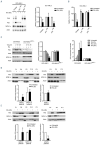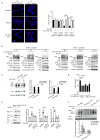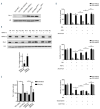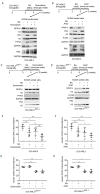A Pin1/PML/P53 axis activated by retinoic acid in NPM-1c acute myeloid leukemia
- PMID: 34047175
- PMCID: PMC8634200
- DOI: 10.3324/haematol.2020.274878
A Pin1/PML/P53 axis activated by retinoic acid in NPM-1c acute myeloid leukemia
Abstract
Retinoic acid (RA) was proposed to increase survival of chemotherapy- treated patients with nucleophosmin-1 (NPM-1c)-mutated acute myeloid leukemia. We reported that, ex vivo, RA triggers NPM-1c degradation, P53 activation and growth arrest. PML organizes domains that control senescence or proteolysis. Here, we demonstrate that PML is required to initiate RA-driven NPM-1c degradation, P53 activation and cell death. Mechanistically, RA enhances PML basal expression through inhibition of activated Pin1, prior to NPM-1c degradation. Such PML induction drives P53 activation, favoring blast response to chemotherapy or arsenic in vivo. This RA/PML/P53 cascade could mechanistically explain RA-facilitated chemotherapy response in patients with NPM-1c mutated acute myeloid leukemia.
Figures





Comment in
-
Pulling the Pin on NPMc+ acute myeloid leukemia.Haematologica. 2021 Dec 1;106(12):3030-3031. doi: 10.3324/haematol.2021.279070. Haematologica. 2021. PMID: 34047523 Free PMC article. No abstract available.
Similar articles
-
Activation of a promyelocytic leukemia-tumor protein 53 axis underlies acute promyelocytic leukemia cure.Nat Med. 2014 Feb;20(2):167-74. doi: 10.1038/nm.3441. Epub 2014 Jan 12. Nat Med. 2014. PMID: 24412926
-
Inhibition of the peptidyl-prolyl-isomerase Pin1 enhances the responses of acute myeloid leukemia cells to retinoic acid via stabilization of RARalpha and PML-RARalpha.Cancer Res. 2009 Feb 1;69(3):1016-26. doi: 10.1158/0008-5472.CAN-08-2603. Epub 2009 Jan 20. Cancer Res. 2009. PMID: 19155306
-
TRIB3 Promotes APL Progression through Stabilization of the Oncoprotein PML-RARα and Inhibition of p53-Mediated Senescence.Cancer Cell. 2017 May 8;31(5):697-710.e7. doi: 10.1016/j.ccell.2017.04.006. Cancer Cell. 2017. PMID: 28486108
-
Novel treatment of acute promyelocytic leukemia: As₂O₃, retinoic acid and retinoid pharmacology.Curr Pharm Biotechnol. 2013;14(9):849-58. doi: 10.2174/1389201015666140113095812. Curr Pharm Biotechnol. 2013. PMID: 24433507 Review.
-
The molecular biology of acute promyelocytic leukemia.Cancer Treat Res. 1999;99:75-124. doi: 10.1007/978-0-585-38571-6_4. Cancer Treat Res. 1999. PMID: 9891864 Review.
Cited by
-
The mechanisms of Pin1 as targets for cancer therapy.Front Immunol. 2024 Nov 18;15:1482088. doi: 10.3389/fimmu.2024.1482088. eCollection 2024. Front Immunol. 2024. PMID: 39624096 Free PMC article. Review.
-
EAPB0503, an Imidazoquinoxaline Derivative Modulates SENP3/ARF Mediated SUMOylation, and Induces NPM1c Degradation in NPM1 Mutant AML.Int J Mol Sci. 2022 Mar 22;23(7):3421. doi: 10.3390/ijms23073421. Int J Mol Sci. 2022. PMID: 35408798 Free PMC article.
-
History of Developing Acute Promyelocytic Leukemia Treatment and Role of Promyelocytic Leukemia Bodies.Cancers (Basel). 2024 Mar 29;16(7):1351. doi: 10.3390/cancers16071351. Cancers (Basel). 2024. PMID: 38611029 Free PMC article. Review.
-
Impact of Anti-T-lymphocyte globulin dosing on GVHD and Immune reconstitution in matched unrelated myeloablative peripheral blood stem cell transplantation.Bone Marrow Transplant. 2022 Oct;57(10):1548-1555. doi: 10.1038/s41409-022-01666-x. Epub 2022 Jul 13. Bone Marrow Transplant. 2022. PMID: 35831408 Free PMC article.
-
Pin1-catalyzed conformational regulation after phosphorylation: A distinct checkpoint in cell signaling and drug discovery.Sci Signal. 2024 Jun 18;17(841):eadi8743. doi: 10.1126/scisignal.adi8743. Epub 2024 Jun 18. Sci Signal. 2024. PMID: 38889227 Free PMC article. Review.
References
-
- Grisendi S, Mecucci C, Falini B, Pandolfi PP. Nucleophosmin and cancer. Nat Rev Cancer. 2006;6(7):493-505. - PubMed
-
- Falini B, Nicoletti I, Martelli MF, Mecucci C. Acute myeloid leukemia carrying cytoplasmic/ mutated nucleophosmin (NPMc+ AML): biologic and clinical features. Blood. 2007;109(3):874-885. - PubMed
-
- Heath EM, Chan SM, Minden MD, Murphy T, Shlush LI, Schimmer AD. Biological and clinical consequences of NPM1 mutations in AML. Leukemia. 2017;31(4):798-807. - PubMed
-
- Kunchala P, Kuravi S, Jensen R, McGuirk J, Balusu R. When the good go bad: mutant NPM1 in acute myeloid leukemia. Blood Rev. 2018;32(3):167-183. - PubMed
MeSH terms
Substances
LinkOut - more resources
Full Text Sources
Other Literature Sources
Medical
Research Materials
Miscellaneous

